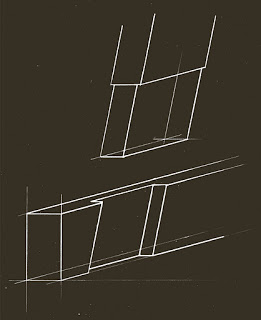The A-frame Easel
By Al R. Young
Building studio equipment isn't always an option, but when it is, it can save a great deal of money and provide custom solutions that can be adapted to the many ways in which technique and projects change over the years.
Of the many easels that are part of the studio's equipment, only a handful were purchased new, a few of those came to us second- or third-hand, and the remainder were designed and built in the studio. Purchased easels include two of the suitcase-style travel models that can be set up easily enough, but require graduate study in order to reconstitute as a suitcase. (You get extra credit if you can transport them without a drawer falling out.) Another is a collapsible, aluminum-tube, table-top easel that accommodates small work. Fortunately, we found each of these on sale. Interestingly, however, the purchased easels receive the least use of any we have.
The A-frame Easel is the first free-standing easel I built. It is Elspeth's favorite, and continues to be one of our primary workhorse easels. It was built in 1992, to serve as a free-standing easel in what would be our new studio. (It's the A-frame Easel because I built it in an A-frame that served temporarily as my woodworking shop for small projects, while our home and studio were being built.)
We've modified the easel from time to time since then (adding storage compartments and other features), but the basic design presented in these diagrams has served well. Its framework is made of 2x6 Douglas Fir. And except for the feet of the two vertical sides, grab screws are used for joinery. A jigsaw was used to cut the pieces.
The following diagram of the side view of the easel presents dimensions. A major safety consideration was to ensure that, given the height of the framework, the length of the runners would keep the easel upright. The use of 2x6s added weight. (I do not like easels that bounce back in response to mu brushwork, which is sometimes quite vigorous.)
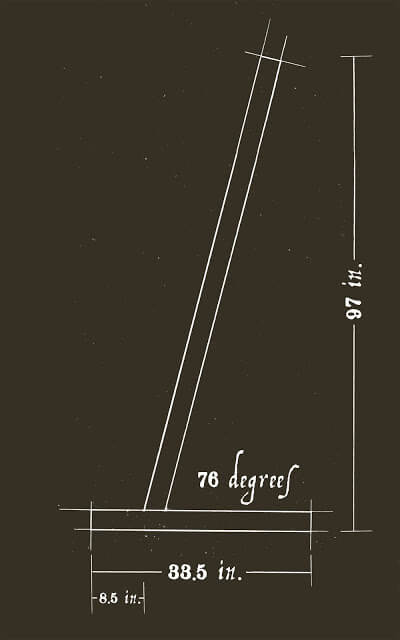 |
| Fig. 1
Side view |
Each runner is made of two 2x6s, and the base of each vertical side is mounted into a runner by means of a mortise and tenon joint. To simplify the task of creating the mortise, I cut it from the inner face of each side of the 2x6s constituting a runner (see Fig. 2).
The following diagram presents a front view of the easel's framework. Each horizontal member is a solid 2x6 running from side to side, and mounted flush with the front surface of each vertical side. The center member is mounted flush with the front surface of the two upper, horizontal braces so that a painting can rest anywhere on the front surface of the easel.
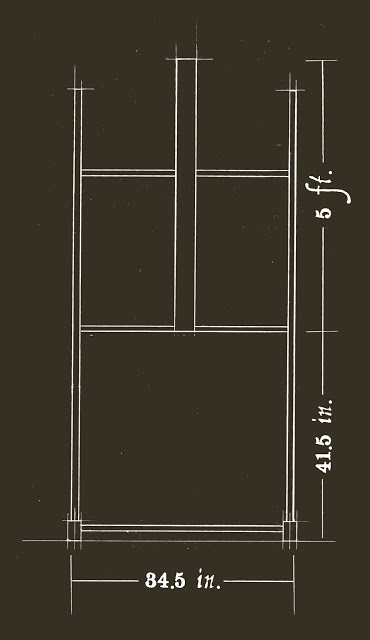 |
| Fig. 3
Front view of easel. The width, from one vertical side to the other, is 34.5 in. Overall height is 101.5 in. |
The foregoing diagram shows a horizontal brace between the runners into which each vertical side of the easel is mounted. This horizontal brace is mounted near the front of the runners. Another brace (not shown) is mounted between the runners near the back of the easel.
The ledge and tray shown in the following photograph is a single unit that "floats" between the two vertical sides. The ledge on which the painting rests is made from a piece of fluted-stock (approx. 4 in. wide) typically used in finish carpentry. The profile of the stock works well for drying-shelves where we store works in progress as well as finished paintings.
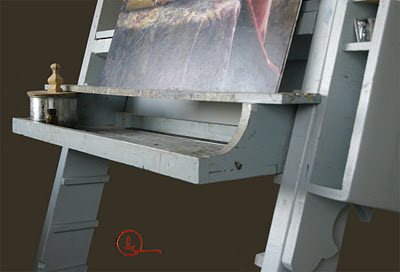 |
| Photograph A |
Narrow runners, mounted to the inner surface of each vertical side of the easel, make it possible to adjust the height of the ledge and tray. It's a little inconvenient to have to remove the painting (and make certain that nothing spills or tumbles to the floor during adjustment), but it works well enough, particularly if the cost of a crank-adjustable easel is prohibitive.
Paint-tube storage (the rectangular compartments to the right in the photograph above) is also provided by a vertical compartment attached to the outer surface of one side of the easel.
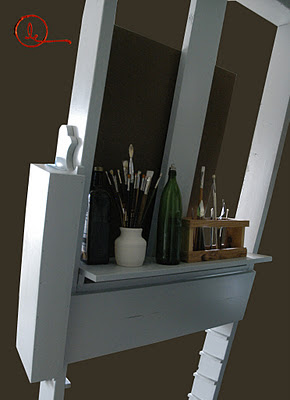 |
| Photograph B |
This photograph of the back of the easel shows the paint-tube storage compartment mounted to the side of the easel (at left in the photograph ). A shelf mounted across the middle of the easel provides storage space.
Browse articles by year: 2025 . 2024 . 2023 . 2022 . 2021 . 2020 . 2019 . 2018 . 2017 . 2016 . 2015 . 2014 . 2013 . 2012 . 2011 . 2010 . 2009 . 2008 . 2007 . 2006 . 2005 . 2004 . 2003 . 2002 . 2001 . 2000 . 1999 . 1998 . 1997 . 1996
Browse articles by topic: Art lessons . BenHaven Archives . Blank art diaries . Fine art photography . Framing . Illustration . Inspiration and creativity . Isles of Rune . Limited Editions Collection . My Fathers Captivity . News . Novellas . Oil paintings and prints . Operations announcements . Orders and shipping . Overview . Portfolios . The Papers of Seymore Wainscott . Project commentaries . Recipes by Nancy Young . Recommended reading . Recommended viewing . Temple artworks . The Storybook Home Journal . Tips and techniques . Tools supplies and operations
Browse articles by topic: Art lessons . BenHaven Archives . Blank art diaries . Fine art photography . Framing . Illustration . Inspiration and creativity . Isles of Rune . Limited Editions Collection . My Fathers Captivity . News . Novellas . Oil paintings and prints . Operations announcements . Orders and shipping . Overview . Portfolios . The Papers of Seymore Wainscott . Project commentaries . Recipes by Nancy Young . Recommended reading . Recommended viewing . Temple artworks . The Storybook Home Journal . Tips and techniques . Tools supplies and operations
